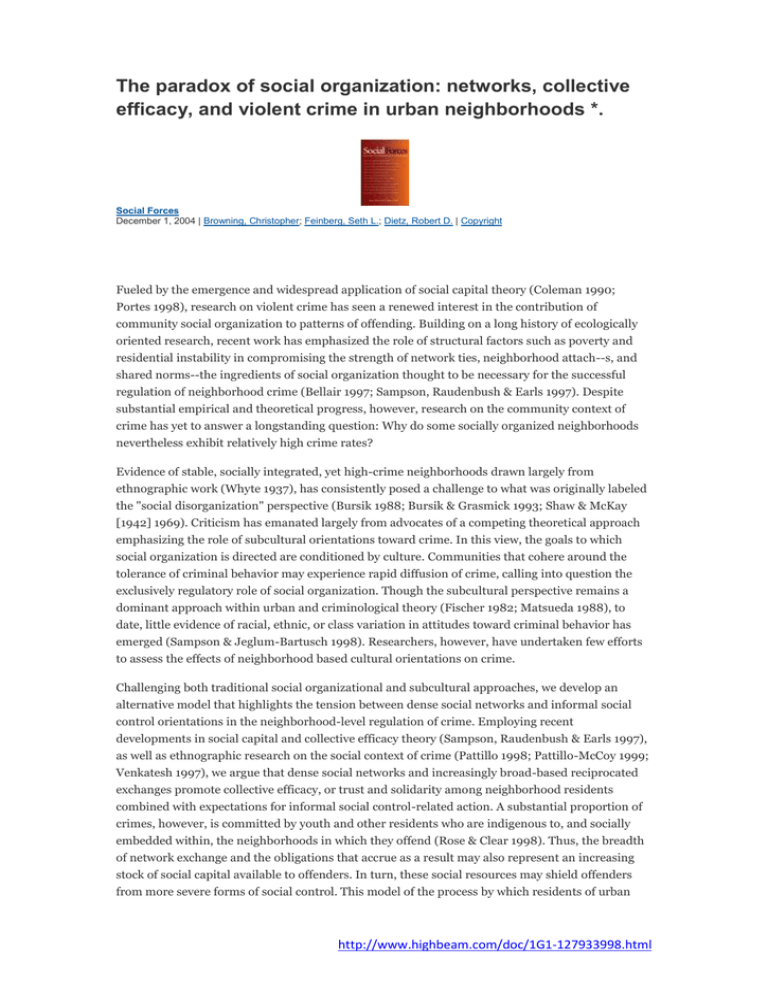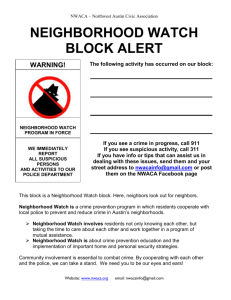The paradox of social organization: networks, collective efficacy, and
advertisement

The paradox of social organization: networks, collective efficacy, and violent crime in urban neighborhoods *. Social Forces December 1, 2004 | Browning, Christopher; Feinberg, Seth L.; Dietz, Robert D. | Copyright Fueled by the emergence and widespread application of social capital theory (Coleman 1990; Portes 1998), research on violent crime has seen a renewed interest in the contribution of community social organization to patterns of offending. Building on a long history of ecologically oriented research, recent work has emphasized the role of structural factors such as poverty and residential instability in compromising the strength of network ties, neighborhood attach--s, and shared norms--the ingredients of social organization thought to be necessary for the successful regulation of neighborhood crime (Bellair 1997; Sampson, Raudenbush & Earls 1997). Despite substantial empirical and theoretical progress, however, research on the community context of crime has yet to answer a longstanding question: Why do some socially organized neighborhoods nevertheless exhibit relatively high crime rates? Evidence of stable, socially integrated, yet high-crime neighborhoods drawn largely from ethnographic work (Whyte 1937), has consistently posed a challenge to what was originally labeled the "social disorganization" perspective (Bursik 1988; Bursik & Grasmick 1993; Shaw & McKay [1942] 1969). Criticism has emanated largely from advocates of a competing theoretical approach emphasizing the role of subcultural orientations toward crime. In this view, the goals to which social organization is directed are conditioned by culture. Communities that cohere around the tolerance of criminal behavior may experience rapid diffusion of crime, calling into question the exclusively regulatory role of social organization. Though the subcultural perspective remains a dominant approach within urban and criminological theory (Fischer 1982; Matsueda 1988), to date, little evidence of racial, ethnic, or class variation in attitudes toward criminal behavior has emerged (Sampson & Jeglum-Bartusch 1998). Researchers, however, have undertaken few efforts to assess the effects of neighborhood based cultural orientations on crime. Challenging both traditional social organizational and subcultural approaches, we develop an alternative model that highlights the tension between dense social networks and informal social control orientations in the neighborhood-level regulation of crime. Employing recent developments in social capital and collective efficacy theory (Sampson, Raudenbush & Earls 1997), as well as ethnographic research on the social context of crime (Pattillo 1998; Pattillo-McCoy 1999; Venkatesh 1997), we argue that dense social networks and increasingly broad-based reciprocated exchanges promote collective efficacy, or trust and solidarity among neighborhood residents combined with expectations for informal social control-related action. A substantial proportion of crimes, however, is committed by youth and other residents who are indigenous to, and socially embedded within, the neighborhoods in which they offend (Rose & Clear 1998). Thus, the breadth of network exchange and the obligations that accrue as a result may also represent an increasing stock of social capital available to offenders. In turn, these social resources may shield offenders from more severe forms of social control. This model of the process by which residents of urban http://www.highbeam.com/doc/1G1-127933998.html neighborhoods achieve a negotiated coexistence acknowledges the potential for network density and reciprocated exchange to both promote, and compete with, collective efforts at social control. In this view, the explanation for the conundrum of socially organized, high crime neighborhoods can be found in the paradoxically countervailing effects of social organization itself. Focusing on the distribution of violent crime in a large urban setting, we test the negotiated coexistence model alongside two competing theories--the systemic reformulation of the traditional social disorganization model (Bursik & Grasmick 1993; Kasarda & Janowitz 1974; Kornhauser 1978), and the ecologically conditioned cultural transmission model (Anderson 1990; Wilson 1996). In addition to simultaneously testing social organizational and cultural transmission theories of urban violence, our research contributes to the literature on community context and crime by (1) investigating the unique and interactive effects of social networks and collective efficacy on the distribution of violent crime, and (2) demonstrating the potential for these dimensions of social organization to compete, with negative consequences for the control of crime. Our analyses employ the Project on Human Development in Chicago Neighborhoods Community Survey (PHDCN-CS)--a dataset specifically designed to investigate the social and cultural processes that underlie community self-regulatory capacity. Theoretical Perspectives We distinguish the theoretical approaches considered by focusing on their divergent expectations regarding the contribution of social networks and oppositional culture to neighborhood variations in violent crime rates. The systemic model, grounded in a vision of sociability as an unalloyed good, views network strength as unconditionally regulatory in its effect oil crime. The cultural transmission model hypothesizes conditional effects of networks depending on the overall level of informal social control characterizing the neighborhood. At low levels of social control, network density is expected to facilitate the transmission of cultural orientations tolerant of deviant behavior, contributing to the dissemination of violent crime. In contrast, the negotiated coexistence model expects that networks will have countervailing effects on crime. While networks promote the willingness of neighborhood residents to engage in informal social control efforts, they simultaneously reduce the regulatory effectiveness of those efforts. We begin by reviewing the traditional social disorganization model of the community level determinants of crime and its more recent systemic reformulation. We then consider the subcultural critique of community social organization models of crime and recent approaches that attempt to identify the social conditions under which alternative or criminogenic oppositional cultural orientations emerge. Finally, we describe the negotiated coexistence model in more detail, highlighting contemporary research on the relationship between networks, collective efficacy, and urban crime. SOCIAL NETWORKS AS THE INFRASTRUCTURE OF SOCIAL CONTROL--THE SYSTEMIC MODEL Scholars of urban life have generally agreed on the elemental role of social ties in the production of viable communities. Early urban research often stressed the role of anonymity and the weakness of social connection in the prevalence of ' http://www.highbeam.com/doc/1G1-127933998.html







